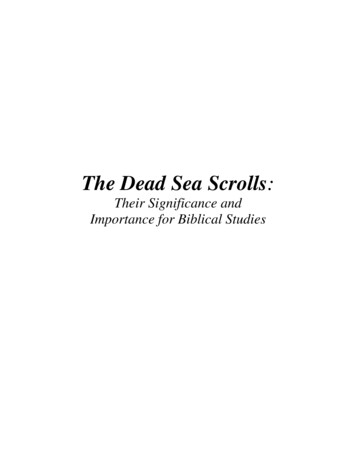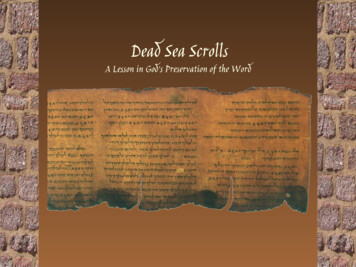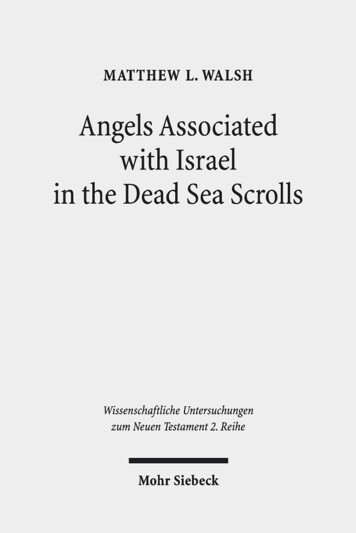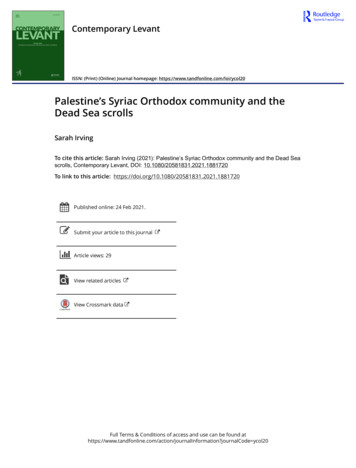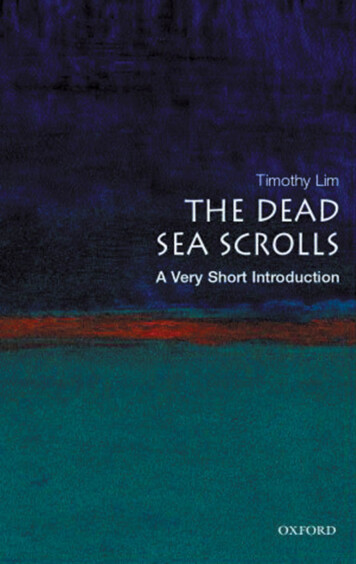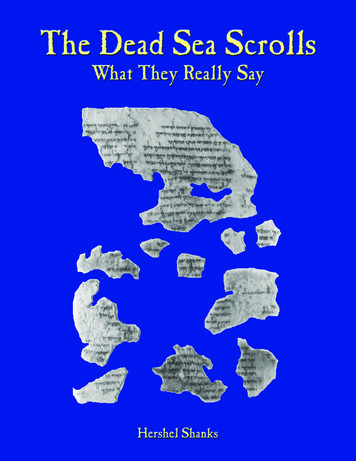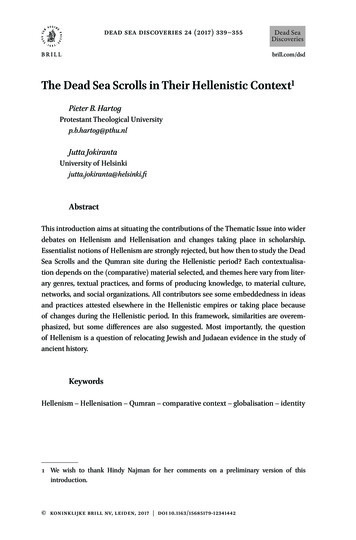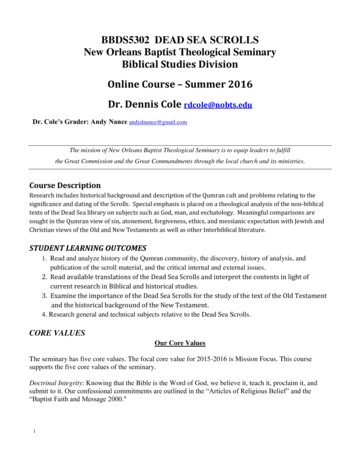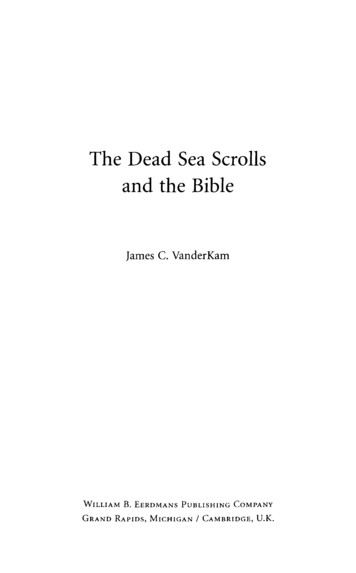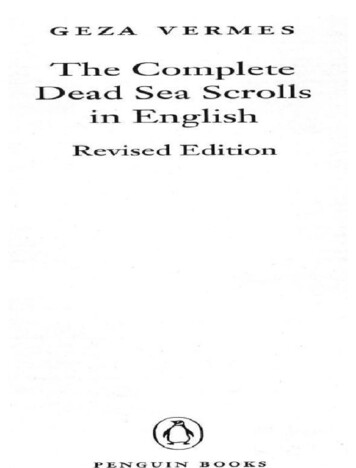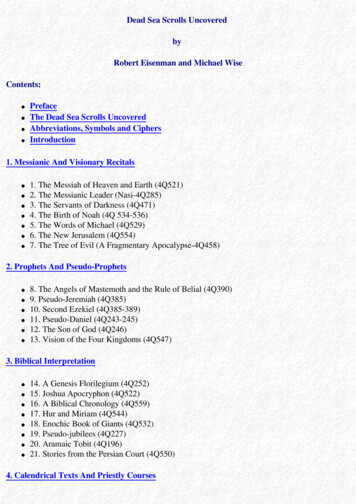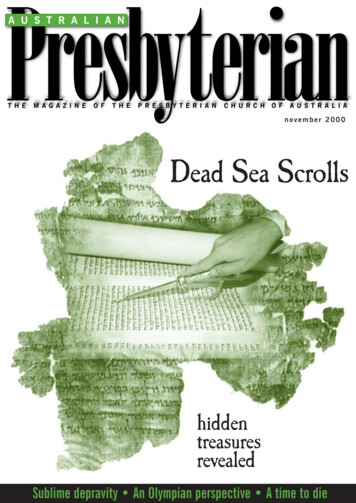
Transcription
november 2000Dead Sea ScrollshiddentreasuresrevealedSublime depravity An Olympian perspective A time to die
Are you ready to develop asa Christian leader?Do you know young Christianleaders who you want to sup-21C is a leadership development conference which will encourage young Christians inleadership, and inspire and equip them for gospel ministry. It is aimed at young leaders (aged 18-28) in the Presbyterian church, not only those interested in full-timeGet more information or an application formatwww.go.to/21c or email us at 21c@go.toor contact John McClean on (02) 6342 1467PO Box 296 Cowra NSW 2794SC HOOL OFCHRISTIAN STUDIESTHEOLOGYAdvancedDiploma/Diploma/Certificate IV Quality evangelical theological educationLecturers with broad ministry experienceACT Accredited, Austudy available,Mature Age entryTrain for ministry or study for interestat ROBERT MENZIES COLLEGEMACQUARIE UNIVERSITY, NORTH RYDEContact us for a ProspectusPh: (02) 9936 6020 Fax: (02) 99366032Email: socs@rmc.nsw.edu.au
November 2000No. 521EDITORIALOLYMPICSEvidence for the defence . . . . . . . . . . . . . . . . . . . . . . . . 4An Olympian view . . . . . . . . . . . . . . . . . . . . . . . . . . . 22DEAD SEA SCROLLSAn event is coming that will make Sydney’s success insignificant,reports John Woods.The dawn of Christianity . . . . . . . . . . . . . . . . . . . . . . . . 5The scrolls enrich our context for the early church, reports BernardSecombe.Scrolls and Scripture. . . . . . . . . . . . . . . . . . . . . . . . . . . 7John Davies talks to Peter Hastie about the scrolls and the Bible.Conspiracy theory. . . . . . . . . . . . . . . . . . . . . . . . . . . . . 9PARENTINGThe disillusioned generation. . . . . . . . . . . . . . . . . . . . . 23Ecclesiastes speaks as cogently today as ever, sugests MarionAndrews.Adrian Schepl finds little to fear in Barbara Thiering’s bizarrechallenge to orthodoxy.BOOKSDEVOTIONIs the New Testament History?. . . . . . . . . . . . . . . . . . . 24Deeply affected . . . . . . . . . . . . . . . . . . . . . . . . . . . . . 11Jesus and the Logic of History . . . . . . . . . . . . . . . . . . . 24Jonathan Edwards on the understanding that draws us closer to God.MISSIONSThe Doctrine of Repentance. . . . . . . . . . . . . . . . . . . . . 24Genesis for Today . . . . . . . . . . . . . . . . . . . . . . . . . . . . 24Land of the Rising Son . . . . . . . . . . . . . . . . . . . . . . . . 12Robert Benn has encouraging news from Japan.LETTERS . . . . . . . . . . . . . . . . . . . . . . . . . . . . . . . . . .25NEWSHome Front . . . . . . . . . . . . . . . . . . . . . . . . . . . . . . . . 13Across Australia . . . . . . . . . . . . . . . . . . . . . . . . . . . . . 14World News. . . . . . . . . . . . . . . . . . . . . . . . . . . . . . . . 15CULTURE WATCHMovie Watch: High Fidelity . . . . . . . . . . . . . . . . . . . . . 17PRAYER . . . . . . . . . . . . . . . . . . . . . . . . . . . . . . . . . .26TOUGH QUESTIONSBaptised in the Spirit?. . . . . . . . . . . . . . . . . . . . . . . . . 27Jason Summers looks again at a vexed question.ESSAYARTA time to die . . . . . . . . . . . . . . . . . . . . . . . . . . . . . . . 28Sublime depravity. . . . . . . . . . . . . . . . . . . . . . . . . . . . 18On 22 November 1963 three famous men appeared before the heav-Art and the Christian: Michael Jensen explores the issues.enly throne. Peter Barnes comments.THE AUSTRALIAN PRESBYTERIAN (ABN 81 498 399 755): The national magazine of the Presbyterian Church of Australia. Acting editor-in-chief: Robert Benn. Editorial committee:Robert Benn (NSW), Stuart Bonnington (WA), Peter Hastie (NSW), Guido Kettniss (Queensland), Barney Zwartz (Victoria). Graphic Design: Sandra Joynt for A&J Moody. Advertisingand subscription inquiries: Walter Bruining, PO Box 375, Kilsyth 3137; Phone: (03) 9723 9684. Subscription: 32 a year GST; bulk (minimum of five copies to one address) 29each GST. Overseas: A43. Office: PO Box 375, Kilsyth 3137. Phone: (03) 9723 9684. Fax: (03) 9723 9685. Email: austpres@bigpond.com Printed: Newsprinters Pty Ltd,Melbourne Road, Shepparton 3060. Published: Monthly except January by the National Journal Committee of the Presbyterian Church of Australia; Convener Robert Benn. Opinionsexpressed are those of the contributor and not necessarily those of the PCA, the editor or the committee. Acceptance of advertising does not imply endorsement. Contributions: Submittedarticles are welcome. The deadline is the first of the previous month. Donations are always welcome. Print Post approved 34918100384. www.presbyterian.org.auAU S T RA L I A N P R E S BY T E R I A N 3
EDITORIALEvidence for the defenceThe Dead Sea Scrolls are a good friend to historic Christianity.In 1947, a young Bedouin shepherd,Muhammed ed Dhib, was playing nearthe top of some cliffs that surroundedthe Dead Sea. He picked up a stoneand threw it into a small hole in the cliffface. There was a sharp crack: the sound ofbroken pottery. Little did he realise that hehad stumbled upon a treasure trove ofancient documents that had lain undisturbed for nearly 2000 years. He had foundthe Dead Sea Scrolls.The Dead Sea Scrolls originallybelonged to a religious community calledthe Essenes, who lived at Qumran. Theywere a Jewish ascetic group who lived primarily in three locations: Qumran at theDead Sea, the Essene Quarter ofJerusalem (Mt Zion), and an area nearDamascus.Archaeologists have established a number of important points about the Essenecommunity. Through the discovery ofcoins on the sites, it appears that the community began in the reign of JohnHyrcanus (134-104BC) and carried onuntil about AD 70 when it was destroyedby the Roman army.Archaeologists believe that when theRoman legions advanced towards Qumran,the inhabitants hid their precious documents in the caves nearby, hoping toretrieve them later. But they never did. Thecommunity was slaughtered. There is evidence that some people returned to the sitelater, around 130-135, but the details aresketchy.Since 1947, further discoveries of documents have been made in the Dead Searegion. William F Albright, the famousleader of the American School of OrientalResearch, wrote shortly afterwards: “Whatan absolutely incredible find! this is thegreatest manuscript discovery of moderntimes.”The significance of the Dead Sea Scrollsstems from their age. Dr W F Libby of theUniversity of Chicago, conducted Carbon14 dating tests on the scrolls in 1950. Thisis a reliable form of scientific dating whenapplied to uncontaminated material severalthousand years old.Dr Libby’s results indicated an age of1917 years for a scroll in Cave 1 with a 200year (10%) variant, which left the datesomewhere between 167BC and AD233.Until 1947, the oldest complete Hebrewmanuscript of the Old Testament was thetext of Codex Leningradensis, dated to1008. This text was made 1400 years afterthe last book of the Old Testament hadbeen written. This was the text used by theKing James translators – the TextusReceptus. It was regarded as the authoritative Masoretic Hebrew text.Obviously that manuscript was a copyof a copy of a copy etc. This raised a pressing question: Could scholars be sure thatthe text in Codex Leningradensis wasidentical to the original text, as given byGod, to the Bible writers? What assurancecould they have that the Bible text today ispure?After carefully comparing the Biblicaltexts, the scholars were amazed to discoverthat, apart from a tiny number of spellingvariations, there were no significant differences between the Dead Sea Scrolls and theMasoretic Text. Albright, himself a formerliberal scholar, declared: “The Dead SeaScrolls prove conclusively that we musttreat the consonantal text of the HebrewBible with the utmost respect and that thefree emending of difficult passages in whichmodern critical scholars have indulged cannot be tolerated any longer.”What does all this show? It demonstrates that the Jews throughout their history have been faithful in copying theBiblical manuscripts with remarkably fewerrors. The text we have today faithfullyrepresents the original autographs. As theJewish historian, Josephus said: “For,although such long ages have now passed,no one has ventured either to add, or toremove, or to alter a syllable”.Further, the Dead Sea Scrolls also contribute to our knowledge of the canon ofthe Old Testament. The canon representsthe collection of books which believersrecognise as inspired by God, and given tothem as Scripture. Jews and Protestantsaccept the 39 books of the Old Testamentas inspired. However, Roman Catholicsalso accept the collection of books knownas the Apocrypha as part of the Bible.Interestingly, every book in the OldTestament, with the exception of Esther,has been found at Qumran. While manyapocryphal books have been found too, it isimportant to note that the only commentaries that have been found at Qumran areAU S T RA L I A N P R E S BY T E R I A N 4of canonical books. This suggests that theEssenes distinguished in their mindsbetween canonical and non-canonical texts.Only the canonical texts seem to have warranted commentaries. This lends supportfor the Protestant view of the canon.As far as the New Testament is concerned, the Dead Sea Scrolls show that theapostolic proclamation of Jesus as thedivine Messiah was consistent with some ofthe messianic expectation of the period.Several Qumran documents, 4Q252,4Q246, and 4Q521 speak of the Messiahbeing of the line of David, having the titles“Son of God” and “Son of the Most High”(as in Luke 1:32-35), as well as having enormous powers such as raising the dead.According to Albright, the Qumran evidence supports the view that the concepts,terminology and mindset of the Gospelsare consistent with a Palestinian setting inthe early first century. In other words, thehistorical data of the New Testament areaccurate and the documents are not aninvention of the church of the second century as was formerly believed by radicalBible critics.As Millar Burrows, a liberal biblicalscholar, admits: “If one will go throughany of the historic statements of theChristian faith he will find nothing thathas been or can be disproved by the DeadSea Scrolls”.Peter HastieFrom the ConvenerIn art, as within thehumans who createit, there is potentialfor both greatbeauty and vileness.Christians,whoknow that artists arefallen, can see truly art’s potential and itslimits, suggests Michael Jensen. Inklings ofGod are present in the human arts – theChristian has been given the eyes of faith tosee them. Jensen’s profound essay beginson page 19.Robert Benn,ConvenerNational Journal Committee ap
D E A DS E AS C R O L L SThe dawn of ChristianityThe scrolls help illumine the early church.The famous Dead Sea Scrolls werefound between 1947 and 1956. Fornearly 19 centuries they lay hiddenin cliff caves above the wadiQumran which runs down to the northwest shore of the Dead Sea. They were thelibrary of a withdrawn priestly communitywhose members possibly slept in the caves,but certainly used the now ruined buildingsnearby for communal meals, ritual bathingand an intense literary activity.A Bedouin shepherd found the firstcave. It had 10 clay jars but only one heldscrolls, though later four more scrolls wereunearthed there. Sensing value in his finds,the shepherd took them to an antiquesdealer who then approached St MarksSyrian Orthodox monastery in Jerusalem,where their significance began to dawn.A search by shepherds and scholarslocated another 10 scroll-bearing caves, andmore than 800 manuscripts. Fewer than adozen were intact however, and many weredecayed to fragments with only a few fadedand uncertain letters.More than 200 books of the HebrewBible came to light plus many previouslyunknown works including specialised commentaries (pesherim) by communityBernard Secombeauthors, hymns, texts on astronomy, apocalypses and various community rules. Mostare written in old Hebrew, some in Aramaicand a few in Greek. Generally they datebetween 200 BC and 68 AD, when theRomans invaded to crush the Jewish revolt.All fragments in cave 7 were in Greek andon papyrus – popular with early Christians.In 1972 a Spanish Jesuit scholar, JoseO’Callaghan, writing in the journal Biblical,claimed to have recognised among thembits of Mark’s Gospel, Acts and severalepistles. His “evidence” was some tinyscraps with only isolated legible letters, andthe only complete word in “Mark” was“and”! The claim has not enjoyed muchsupport.A better prospect for a New Testamentlink was the Aramaic fragment from cave 4which says that some unidentified personshall be hailed as the Son of God and calledSon of the Most High. These titles remindus of Luke’s nativity record but even so, asfar as I know, no scholar has asserted a linkbetween them. In fact there is no real evidence that any NT author looked toQumran for ideas, and the community’sown writings do not refer to any works thatlater formed the New Testament.Nor can the unnamed but distinctivepersonages in Qumran’s writings – theTeacher of Righteousness and his persecutor, the Wicked Priest – be identified withany New Testament characters. Thoughone Sydney scholar thinks the Teacher wasJohn the Baptist and the Wicked Priest wasJesus, she has almost no support (but muchstrong opposition) from internationalscholarship. Jesus was not a priest inQumran’s terms, and there is no evidencethat he “persecuted” John; indeed Matthew11 records their mutual respect.Paleographers and modern dating techniques date the relevant Qumran writingsup to two centuries before John and Jesus.This includes the time of Maccabean inter-AU S T RA L I A N P R E S BY T E R I A N 5
D E A DThe two Bedouin shepherds who foundthe scrollsference with the High Priesthood; and manyscholars see the Teacher and Wicked Priest ascontestants in that struggle, between 160and 140 BC. Probably this struggle was thegenesis of the sect.Qumran’s writings evolved during longpolitical/social unrest, including the Romanpresence since 63 BC. Their introspectivelegalism contrasts with the freer, outgoinginterpretation by Jesus of God’s earlier revelation. He himself did not fit their apparentexpectations of two Messiahs (Deliverers) one Aaronic and priestly, and one Davidic,military and political. I say “apparent”because there was also mention of a ProphetMessiah, and a recently released text (40521)looked for only one Messiah, and hisexpected ministry was not unlike that ofJesus. Even so, this does not form any linkbetween Qumran and Jesus’ ministry.Moreover, by his sacrifice and triumph, Jesusbroke the bounds of their parochial ideas ofNew Covenant.Yet with all the differences, there are similarities in ethics and theology – naturally,since both groups had deep Jewish roots.Both also had convictions of being a righteous remnant living in the “last days”. Johnthe Baptist was a pivot between a complexJudaism and the Lord’s teaching and passionwhich was the dawn of Christianity.Josephus,thefirstcenturyJewish/Roman historian, tells us that the(celibate) Essenes would receive the young(male) children of other people andraise/instruct them in their way of life. Johnwas the child of an old priest and “he grewand became strong in spirit; and lived in thedesert until he appeared publicly to Israel”(Luke 1:80). Where in the desert would thisbe possible for one impliedly so young?S E AS C R O L L SMany scholars think that John, with hisascetic lifestyle, might have been reared atQumran, and that his hallmark baptism wasan adaptation of their ritual bathing.Though unprovable, this theory is notunreasonable. His ministry began quite closeto Qumran (Luke 3:2,3). His vocation (Mt3:3) used the same Isaiah passage (40:3)which the Qumran community (based in thedesert) claimed for their own mission; andhis vivid language (Mt 3:7-12) compareswith their visionary expectations. His baptism, an initiation rite to publicise personalrepentance and life-changing faith, apparently ignored the Temple system whose leaders Qumran saw as corrupt. Although somethink they were Sadducees, I accept that theQumran devotees were Essenes and thatthere was an Essene “quarter” in Jerusalem,with others spread among Judaean society.Though the New Testament does not mention them, they were a fact of life during theLord’s ministry. By tradition, his wildernesstemptation was in that region and he did visitJericho, only about 12 sparsely inhabitedkilometres away. Without suggesting anycontact between them, I think Jesus was wellaware of Qumran and its teaching.In reacting to Greek and Roman culturalinfluences in Jerusalem, Qumran was stillthoroughly Jewish and priestly. Their ownwritings show this clearly even while revealing creative thinking and unusual practices.They actually used a different calendar: solarwith 364 days as against the lunar with 354days. Thus they celebrated holy days andfeasts out of timing with other Jews.Qumran offers a much better understanding of Jewish life and thought duringthe inter-testamental period than we hadbefore. Thus they enrich our view of thesocial, spiritual and intellectual culture thatformed the background for dawningChristianity.Specific differences of thinking include: The Gospels: As in Matthew 5, there arebeatitudes in 4Q525 – example “Blessed isthe man who has attained Wisdom and walksin the law of the Most High”. However theylack the promise of following blessings thatall Jesus’ beatitudes have - “.for they will.”The Sermon on the Mount also shows Jesusopposing some pervasive Essene doctrines.Matt 5:43 reads “You have heard that it wassaid ‘Love your neighbour and hate yourenemy’.” This is hugely negative: It was notan Old Testament injunction, but it wastaught at Qumran – the Sons of Light wereto hate the Sons of Darkness. The Lord’semphasis in v44 (“Love your enemies.”)intensifies the clear Old Testament principleof God’s compassion. Qumran’s Sabbath rules were more severethan those of the Pharisees who would atleast pull an animal from a pit on the SabbathAU S T RA L I A N P R E S BY T E R I A N 6(Mt 12:11,12). Qumran wrote “Let no manassist a beast in birth on the Sabbath, even ifshe drops [her young] into a cistern or pit,let him not lift it up.” (DamascusDoc.11/13) They also forbade mingling withothers, or being anywhere near Gentiles onthe Sabbath. Jesus mingled in synagogues onthe Sabbath, pointedly healed on that day,and taught that acts of mercy to man orbeast were consistent with God’s benevolentintention for the Sabbath. With their focus on priestly holiness (seeLev. 21), Qumran rigorously excluded anyone with mental or physical defects. Jesus’compassion however included such people –disabled, diseased and demoniacs – as well as“prostitutes and sinners”. Yet Qumran and dawning Christianity hadcomparable views of God’s grace and man’sneed of it. In the Community Rule (say 125BC) we read: “As for me, I belong to an evilhumanity. My iniquities, transgression andsin, together with the perversity of my heart.and man is unable to establish his stepssince justification is with God, and from hishand is integrity of way”. Their hymns alsooften emphasised God’s grace and mercy,and acknowledge that justification is fromhim. Indeed they had grasped fromHabakkuk that the just man shall live by hisfaith, the very essence of Jesus’ message andPaul’s. Their strenuous efforts to be pure andholy were not attempts to earn salvation, butto express devotion. Gospels and epistlesalign with this. Paul: The Community Rule also speaks oftrue righteousness being instilled into aman’s heart “in a spirit of humility, patience,Scroll jar
D E A Dabundant charity, unending goodness, understanding . mighty wisdom which trusts in alldeeds of God and leans on his great loving kindness”. This compares with the Fruit of the Spiritin Galatians 5. Paul’s other list there, headed“acts of the sinful nature” is not unlike theRule’s “ways of the spirit of falsehood”. This listalso perceptively includes “slackness in thesearch for righteousness”. Jude: (v14,15) quotes from the apocryphal 1stBook of Enoch, and this raises interesting questions about lines of “inspiration”. Qumran hadabout 20 copies of 1 Enoch (more than ofGenesis, Exodus or Leviticus) which suggeststhat this book had the status of Scripture there,and possibly elsewhere. This could help toexplain Jude’s usage. Revelation: The Temple Scroll is the longestwriting from the caves. At length, it describes afuturistic (and seemingly ultimate) Temple, vast,gilded and glorious – grander by far than Herod’sTemple which was not yet built. However it wasearthly, and it apparently represented their aspirations vis-a-vis the shunned priestly regime inJerusalem. By contrast, the New Testament’sfuturistic vision was the New Jerusalem (Rev. 21)which needed no temple at all!Qumran’s scrolls and scraps represent morethan 20 copies each of Deuteronomy, Psalmsand Isaiah; with many quotations/allusions intheir own writings from those books. This compares with early Christian usage of JewishScripture, though of course, emphases differed.For example; Qumran stressed Psalms 37, 78 &106 while Christians preferred Psalms 2, 40 &110.Thus the two groups varied in their interpretations of the essence of historic Judaism. Onewas an earnest human quest, with some enlightened glimpses, but was also rather reactionaryand withdrawn from society. Though withoutself righteousness, they had a somewhat brittleattitude. During the Jewish revolt of 66-70 AD,Rome easily crushed it all; and it was then longforgotten – until its scrolls were found. Theother sprang from a long promised divine initiative to meet human need. It showed andencouraged a revolutionary, outgoing love, asmany parables and miracles attest. It graspedthat the only Messiah devotedly died as a sinners’ substitute and rose again, to set penitentsfree from bondage to the Law, sin and death. Itspowerful message eventually captured Romeand its empire, although, tragically, in theprocess, it lost much of its sense of spiritualfreedom, and some even returned to Qumran’sidea of withdrawing from society.Bernard Secombe is a member of St GilesPresbyterian Church, Hurstville. He recentlycompleted his Masters in Judaic Studies.The New South Wales Art Gallery held an exhibition on the Dead Sea Scrolls from July to October.apS E AS C R O L L SQumran’s legacyJohn Davies tells Peter Hastiehow the scrolls help us understand the Bibleor so before Jesus, though some overlaphis ministry. They are Jewish writingsrather than Christian, though they tell usa lot about at least one branch of Judaismat the time of Jesus and a bit before. This,of course, is very relevant to the study ofChristian origins.So how many scrolls are there, andwhat do the writings consist of?John DaviesThere seems to have been quite aflurry of interest in the media latelyabout the Dead Sea Scrolls. Why isthat?Well, a few of the scrolls have been onexhibit in Australia, which has sparkedsome of the recent interest. However, themain reason is that it’s only relativelyrecently that the scrolls have been fullypublished and translated, at least in a preliminary edition. This gives us access tothe life and thought of the people whowrote them, people who lived close to thetime of Jesus’ ministry. They’re a windowon a significant aspect of our cultural heritage. I suppose too, the romance of theScrolls’ accidental discovery in 1947 andthe intrigues surrounding their acquisition by the Israeli authorities, probablycontribute to their mystique.What exactly are the Dead SeaScrolls?The term is used to describe anyancient writings found in the vicinity ofthe Dead Sea. There are a number of sitesaround its shores where scrolls have beenfound. Because of the dryness of the climate, the organic materials of the scrollswere able to survive there, whereas theywould have perished in a wetter climate.Mostly, the term refers to those scrollsfound at one site, Qumran on the northwest shore, in a series of 11 caves. That’swhere the vast majority of the scrollsfrom the Dead Sea were found.Are Christian writings amongthem?No. There have been a couple ofclaims that some, at least, of the scrollsare early Christian writings. But this isn’tgenerally reckoned to be correct. Manyof the scrolls can be dated to the centuryThere are many scrolls represented –in Hebrew, Aramaic and a few in Greek.There are a few scrolls which are relatively complete, like the main Isaiahscroll, but most of them are in small fragments. Putting them together has beenlike putting together 800 jigsaw puzzleswhere most of the pieces are missing andthose that remain are badly damaged andall mixed together. In most cases, thereisn’t any picture on the box to helpeither!Many of the scrolls are parts of theOld Testament – all books except Estherare represented by at least one copy.Some of the scrolls are other Jewish writings we knew about before, such asJubilees, Sirach, and Psalm 151. However,many are documents we didn’t knowabout, such as the War Scroll, theCommunity Rule and the Temple Scroll.There are also various liturgies and somecommentaries on books of the OldTestament as well as parts of the OldTestament strung together in much thesame way that some New Testamentwriters collate Old Testament texts. Notall of the Scrolls have been given descriptive titles like those I’ve already mentioned. Most of them just have a cavenumber and a fragment number.So who exactly wrote these scrolls?Well, many of them are copies of olderscrolls, like the Biblical scrolls, for example. The ones which are original compositions, or some of them at least, mayhave been written close to where theywere found. There is a set of buildings atQumran, which was probably the centreof a community of Jews in the Dead Seaarea. It seems that these people weremainly priests, who had withdrawn fromthe temple in Jerusalem about the middleof the second century BC in protest atwhat they saw as abuses there.AU S T RA L I A N P R E S BY T E R I A N 7
D E A DSome of the scrolls seem to have a dissenting or sectarian flavour. For one thing,they operate on a different calendar fromthat which became the orthodox Jewishcalendar. This community is thought tohave been made up of Essenes, a Jewish sectwe know of from other sources. There areother theories about them, but that’s stillthe generally accepted view. Of course wecan’t rule out the possibility that many ofthe scrolls found in the caves were broughtthere from other places in Judea or beyond,and they might represent a somewhatbroader spectrum of the varieties ofJudaism at the time.Some say the scrolls undermine theauthority of the Bible. Is there anysubstance to that claim?It’s hard to see how. The Biblical scrollsfound in the Dead Sea region provide evidence for the text of the Old Testamentwhich is about 1000 years earlier than theearliest surviving manuscripts we had priorto their discovery. There are some minordifferences, and at some points they maycorrect the readings of later manuscripts.These corrections are usually worked intomodern Bibles, and you sometimes see afootnote telling you this.The sectarian scrolls, that is the nonBiblical ones, simply fill out our picture.They correct to some extent our understanding of Judaism around the time ofJesus. They certainly don’t contradict whatwe know from the Bible.Doesn’t Barbara Thiering say therehas been a huge conspiracy by thechurches to suppress the scrollsbecause they are afraid that theChurch’s teaching will be provedwrong?I don’t want to be unkind to a formerlecturer of mine at Sydney University, butDr Thiering is very much a lone voice. TheAustralian press likes to treat her as a worldauthority but, apart from a few scholarswho refute her, she scarcely rates a footnote in any serious discussion of the scrollsthese days.Her theories about the Scrolls being acoded message, totally at variance with theNew Testament account of Jesus, simplywon’t stand up. The carbon-14 dating andother related analyses of the Scrolls makeher views impossible, and in any case, herreconstruction is the result of a string ofuncontrolled speculations.I remember when she was lecturing mesome time ago, she said that Jesus shouldbe identified with the revered individualknown in the scrolls as the Teacher ofRighteousness. Now she thinks, with nomore evidence, he is the arch-enemy of theTeacher, the Wicked Priest. It’s true that theS E AS C R O L L Sscrolls were a long time in being released,and it’s true that there was someJewish–Christian rivalry in the early days ofthe project which contributed to thedelays. Scholarship is not the detached pursuit we might like to think it is. Politics andprofessional jealousy play their part. Butthere has been no conspiracy to suppressthe scrolls. I was at a seminar in Sydneyrecently, where three eminent Jewish scholars working on the scrolls, one of them thecurrent chief editor of the project, said thatany notion of an attempt by the church tosuppress the scrolls was nonsense.What do the scrolls reveal aboutsome of the main elements ofJudaism around the time of Jesus?The scrolls reveal an interesting combination of scrupulous concern for the law,and correct ritual procedure as the Essenesunderstood it. Their zeal for the law wasmixed with a warm devotion to God, whichthey expressed in some of their hymns,which we could sing today. Their writingsreveal that they indulged in a lot of speculation about what they saw as the comingshowdown between the forces of God andthe forces of darkness, and the coming ofthe messiah, or rather two messiahs.Two messiahs?Yes. They hadn’t realised that the faithful priest and the faithful king promised inthe Old Testament could be one and thesame person, as Jesus revealed himself tobe. The priesthood figures prominently inthe community and its thinking. Thescrolls combine priestly and visionary elements which were previously thought tobelong to opposite ends of the Jewish theological spectrum.How did the community at Q
the Dead Sea. He picked up a stone and threw it into a small hole in the cliff face. There was a sharp crack: the sound of broken pottery. Little did he realise that he had stumbled upon a treasure trove of ancient documents that had lain undis-turbed for nearly 2000 years. He had found the Dead Sea Scrolls. The Dead Sea Scrolls originally
